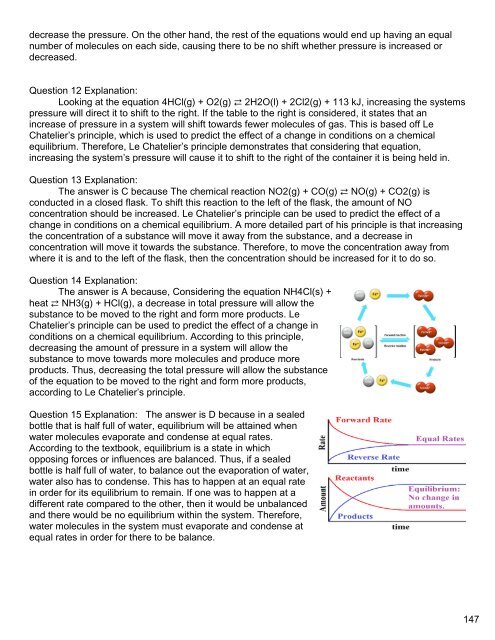You also want an ePaper? Increase the reach of your titles
YUMPU automatically turns print PDFs into web optimized ePapers that Google loves.
decrease the pressure. On the other hand, the rest of the equations would end up having an equal<br />
number of molecules on each side, causing there to be no shift whether pressure is increased or<br />
decreased.<br />
Question 12 Explanation:<br />
Looking at the equation 4HCl(g) + O2(g) ⇄ 2H2O(l) + 2Cl2(g) + 113 kJ, increasing the systems<br />
pressure will direct it to shift to the right. If the table to the right is considered, it states that an<br />
increase of pressure in a system will shift towards fewer molecules of gas. This is based off Le<br />
Chatelier’s principle, which is used to predict the effect of a change in conditions on a chemical<br />
equilibrium. Therefore, Le Chatelier’s principle demonstrates that considering that equation,<br />
increasing the system’s pressure will cause it to shift to the right of the container it is being held in.<br />
Question 13 Explanation:<br />
The answer is C because The chemical reaction NO2(g) + CO(g) ⇄ NO(g) + CO2(g) is<br />
conducted in a closed flask. To shift this reaction to the left of the flask, the amount of NO<br />
concentration should be increased. Le Chatelier’s principle can be used to predict the effect of a<br />
change in conditions on a chemical equilibrium. A more detailed part of his principle is that increasing<br />
the concentration of a substance will move it away from the substance, and a decrease in<br />
concentration will move it towards the substance. Therefore, to move the concentration away from<br />
where it is and to the left of the flask, then the concentration should be increased for it to do so.<br />
Question 14 Explanation:<br />
The answer is A because, Considering the equation NH4Cl(s) +<br />
heat ⇄ NH3(g) + HCl(g), a decrease in total pressure will allow the<br />
substance to be moved to the right and form more products. Le<br />
Chatelier’s principle can be used to predict the effect of a change in<br />
conditions on a chemical equilibrium. According to this principle,<br />
decreasing the amount of pressure in a system will allow the<br />
substance to move towards more molecules and produce more<br />
products. Thus, decreasing the total pressure will allow the substance<br />
of the equation to be moved to the right and form more products,<br />
according to Le Chatelier’s principle.<br />
Question 15 Explanation: The answer is D because in a sealed<br />
bottle that is half full of water, equilibrium will be attained when<br />
water molecules evaporate and condense at equal rates.<br />
According to the textbook, equilibrium is a state in which<br />
opposing forces or influences are balanced. Thus, if a sealed<br />
bottle is half full of water, to balance out the evaporation of water,<br />
water also has to condense. This has to happen at an equal rate<br />
in order for its equilibrium to remain. If one was to happen at a<br />
different rate compared to the other, then it would be unbalanced<br />
and there would be no equilibrium within the system. Therefore,<br />
water molecules in the system must evaporate and condense at<br />
equal rates in order for there to be balance.<br />
147



